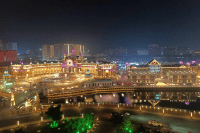The streets of Tbilisi were closed off just a few weeks ago for Independence Day, celebrating the day Georgia formally left the Russian Empire. Thousands of local families lined the roads, cheering as columns of soldiers marched past, waving not just one flag, but three.
As well as the red and white five-cross national banner, hundreds had brought out the gold and blue colours of Ukraine that have been put up everywhere across the capital, hanging from apartment building balconies and shopfronts as a sign of support since the start of the war. Given around a fifth of Georgia’s territory is still under occupation by Russian forces and their proxies following wars in Abkhazia and South Ossetia, many have firsthand experience of Moscow’s divide and conquer tactics.
Yet more people, however, were flying the flag of the EU. Even outside of celebrations and state visits, the flag’s gold stars are draped over government buildings and flown from lampposts at every opportunity – more so than in many countries that actually are part of the bloc.

Get Britain's best politics newsletters
Register to get The Spectator's insight and opinion straight to your inbox. You can then read two free articles each week.
Already a subscriber? Log in








Comments
Join the debate for just $5 for 3 months
Be part of the conversation with other Spectator readers by getting your first three months for $5.
UNLOCK ACCESS Just $5 for 3 monthsAlready a subscriber? Log in